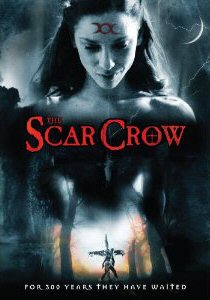
The Scar Crow begins by taking us back to, roughly, the start of the eighteenth century, and the witch trials which ended the lives of many women and men of the period: an accused witch, Elizabeth Tanner, is being put to death, in an arresting opening scene which manages to be nasty but still low-key. Interestingly, the film takes the perspective of viewing Tanner family life after this catastrophe: Elizabeth's young daughters were amongst the crowd watching her execution, and they must try to go back to everyday life after this, although life cannot be the same for several reasons. Their father maniacally rejects everything associated with his wife, burning her books and scrolls (because, it seems, the accusations against her weren't groundless after all); he also begins to sexually abuse the two eldest daughters, Vanessa (Marysia Kay) and the oddly-named Proper (Gabrielle Douglas).
We then skip forward in time to the modern day, however, and witness a guy, Darren (Kevyn Connett), waking from a nightmare. He begins describing to his worried girlfriend what he believes is giving him these bad dreams, telling her what happened after a 'team building' exercise he took part in with his friends and colleagues where they were dropped in the countryside with minimal supplies and a target of orienteering their way to a target base. They had other ideas, though, which involved cheating hanging out at the nearest pub they could find and then getting their mate to give them a lift to their destination. On their way, they spotted the three sisters we met earlier still living on their farmstead as if time hadn't moved at all. Being a bunch of Jack the Lads, they decided to try it on with the girls but obviously, all is not as it seems. Are the girls ghosts? Wraiths? As their story unfolded, the danger to their unsuspecting guests grew more palpable.
The first thing I'd say about The Scar Crow is this: hallelujah for a British indie horror which has ambition. It would have been the easiest and the most boring thing in the world to roll out some pisspoor zombies or to flail through the countryside making a found footage movie. Thankfully, this film doesn't do that, and has lots of ideas, some truly macabre and menacing. The historical setting was a brave move to make and this film could even have worked as a straightforward historical horror, although the structure it elects to use has its own potential. Still, it owes something along the way to older British horrors like Blood on Satan's Claw, even if it plays out vastly differently. The air of occult goings-on and the brutal aspects of society at the time have a long pedigree, and seeing any variation on these is massively welcome.
Still, although there's a lot to like about The Scar Crow, it does suffer with some problems in tone. Its structure works well in some ways, but it brings up as many problems. This is a shame because, in some places where atmosphere begins to build up nicely, some of the script and delivery derails it somewhat. In particular, some of the awkward laddish lines spoken by the guys sound unnatural, even if we accept that these are supposed to be shallow and silly characters; on the other side of the coin, the way in which the sisters over-pronounce some of their lines can be jarring. The overall effect distanced me from the plot, at least to an extent. More naturalistic lines would have made a big difference here. I also found some of the camera effects unnecessary. There are sequences where footage gets slowed down/sped up or has other shots superimposed over it a little of this type of work can be fine, but its overuse does not cover a multitude of sins.
So, there are problems here, possibly because of the ambition which makes it stand out in the first place, but The Scar Crow has imagination, and that does count for a great deal. It encompasses historical roots, adds in some blood and (literal) guts and attempts to offer something different, and all on a shoestring budget. Give me a film like this which tries to do too much and moderately succeeds in what it does try, than ten which try to do too little and absolutely succeed at doing very little.
The MVD Visual release comes in at 83 minutes, is chaptered, and by way of special features you get a 'Making Of' documentary and the original trailer. Being a low-budget movie, the cinematic quality is not brilliant, but the version we get is definitely watchable, and the audio track is nice and clear.
Review by Keri OShea
| Released by Jinga Films |
| Region 1 |
| Not Rated |
| Extras : |
| see main review |